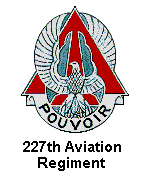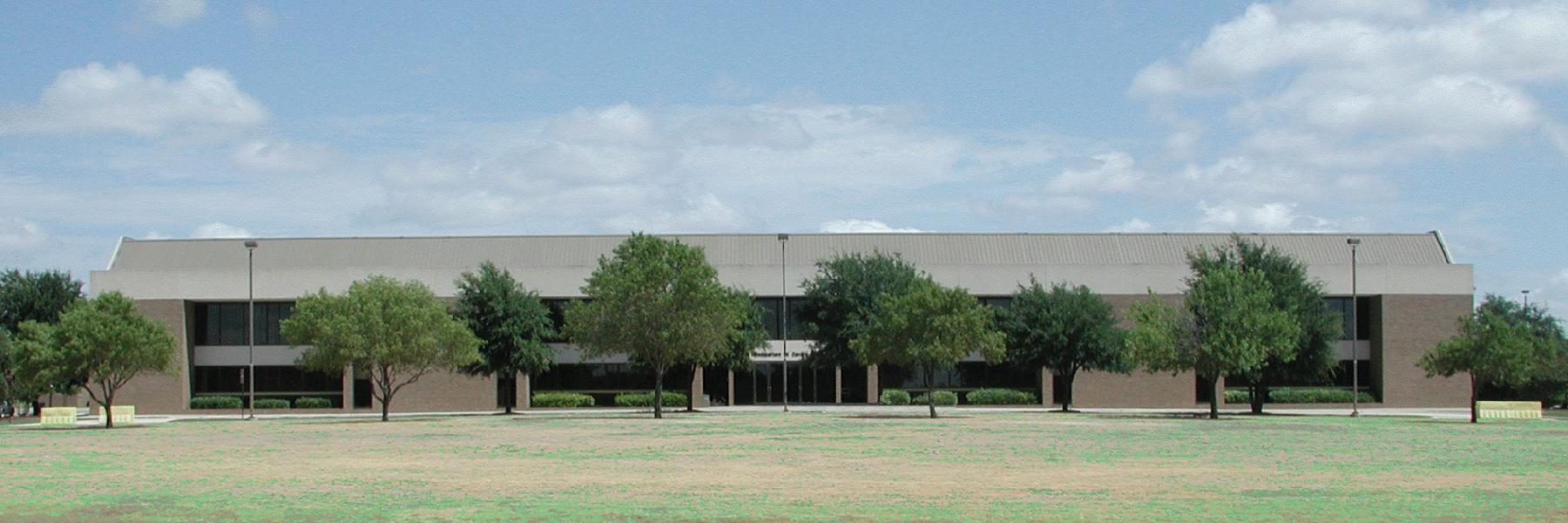

227th Aviation Regiment
In Readiness
"POWER"; or "CAN DO"

![]()



![]()
|
|---|
![]() TRICAP, an acronym for TRIple-CAPability, was derived from combining the
ground (mechanized infantry or armor) capability, airmobile infantry and air
cavalry or attack helicopter forces. TRICAP I was held at Fort Hood, Texas
beginning in February 1972. The purpose of TRICAP I was to investigate the
effectiveness and operational employment of the TRICAP concept at battalion
and company levels when conducting tactical operations in a 1979 European
mid-intensity warfare environment. The exercise consisted of six phases;
movement to contact, defense and delay, exploitation, elimination of
penetration, rear area security and night elimination of penetration in an
adjacent area.
TRICAP, an acronym for TRIple-CAPability, was derived from combining the
ground (mechanized infantry or armor) capability, airmobile infantry and air
cavalry or attack helicopter forces. TRICAP I was held at Fort Hood, Texas
beginning in February 1972. The purpose of TRICAP I was to investigate the
effectiveness and operational employment of the TRICAP concept at battalion
and company levels when conducting tactical operations in a 1979 European
mid-intensity warfare environment. The exercise consisted of six phases;
movement to contact, defense and delay, exploitation, elimination of
penetration, rear area security and night elimination of penetration in an
adjacent area.
![]() By 31 March 1972, only ninety-six thousand US troops were involved in the
Vietnam combat operations. In mid June 1972, the stand-down ceremony for the
3rd Brigade was held in Bein Hoa and the colors were returned to the United
States. The last trooper left from Tan Son Nhut on 26 June, completing the
Division recall which had started on 05 May 1971. With the 3rd Brigade
completing its withdrawal, the 1st Cavalry had become the first US Army
Division to go to Vietnam and the last to leave.
By 31 March 1972, only ninety-six thousand US troops were involved in the
Vietnam combat operations. In mid June 1972, the stand-down ceremony for the
3rd Brigade was held in Bein Hoa and the colors were returned to the United
States. The last trooper left from Tan Son Nhut on 26 June, completing the
Division recall which had started on 05 May 1971. With the 3rd Brigade
completing its withdrawal, the 1st Cavalry had become the first US Army
Division to go to Vietnam and the last to leave.
![]() On 26 June 1972, the 1st Battalion, 7th Cavalry; 2nd Battalion, 8th Cavalry;
and the 1st Battalion, 12th Cavalry along with the 3rd Brigade (Separate) was
brought back to the United States, completing the last stage of the "Vietnam
recall" for the 1st Cavalry Division. The return of the units brought about
several changes to the organizational structure of the 1st Cavalry Division.
On 28 June the 2nd Battalion, 8th Cavalry was inactivated at Ft. Hood, TX. and
on 29 June the 1st Battalion, 12th Cavalry replaced the 2nd Battalion, 12th
Cavalry Regiment which was inactivated at Ft. Hood, Texas. On 22 August, the
1st Battalion, 7th Cavalry was inactivated at Ft. Hood, Texas followed by the
inactivation of the 4th Squadron, 9th Cavalry at Ft. Hood, Texas on 13
September 1972.
On 26 June 1972, the 1st Battalion, 7th Cavalry; 2nd Battalion, 8th Cavalry;
and the 1st Battalion, 12th Cavalry along with the 3rd Brigade (Separate) was
brought back to the United States, completing the last stage of the "Vietnam
recall" for the 1st Cavalry Division. The return of the units brought about
several changes to the organizational structure of the 1st Cavalry Division.
On 28 June the 2nd Battalion, 8th Cavalry was inactivated at Ft. Hood, TX. and
on 29 June the 1st Battalion, 12th Cavalry replaced the 2nd Battalion, 12th
Cavalry Regiment which was inactivated at Ft. Hood, Texas. On 22 August, the
1st Battalion, 7th Cavalry was inactivated at Ft. Hood, Texas followed by the
inactivation of the 4th Squadron, 9th Cavalry at Ft. Hood, Texas on 13
September 1972.
![]() On 21 February 1975, the end of TRICAP evaluations, the mission of airmobile
anti-armor warfare was transferred to the 6th Cavalry Brigade (Air Combat)
co-located at Fort Hood, Texas and the 1st Cavalry Division was reorganized
and redesignated to become the newest Armored Division in the Army,
essentially the battle configuration it retains until the Divisional Modular
Reorganization that it retains today.
On 21 February 1975, the end of TRICAP evaluations, the mission of airmobile
anti-armor warfare was transferred to the 6th Cavalry Brigade (Air Combat)
co-located at Fort Hood, Texas and the 1st Cavalry Division was reorganized
and redesignated to become the newest Armored Division in the Army,
essentially the battle configuration it retains until the Divisional Modular
Reorganization that it retains today.
![]() On 08 August 1977, in the continuing wrestling with the role of divisional
aviation assets, the 1st Squadron, 9th Cavalry Regiment, 19th Combat and the
General Support Aviation Companies were assigned to the Aviation Brigade,
filling out its organizational needs. This change was augmented on 21 May,
1978 when the 227th Aviation Company was reorganized and designated the 1st
Battalion, 227th Aviation with organic elements concurrently activated.
On 08 August 1977, in the continuing wrestling with the role of divisional
aviation assets, the 1st Squadron, 9th Cavalry Regiment, 19th Combat and the
General Support Aviation Companies were assigned to the Aviation Brigade,
filling out its organizational needs. This change was augmented on 21 May,
1978 when the 227th Aviation Company was reorganized and designated the 1st
Battalion, 227th Aviation with organic elements concurrently activated.
 |
|---|
| 1st Cavalry Division Headquarters - 1983 |
![]() These two aviation assets, the 1st Battalion, 227th Aviation Regiment and the
Provisional Aviation Brigade, continued concept testing and Divisional
operational support until 01 September 1984, when the provisional status of
the Division Aviation Brigade was removed and the unit was official activated
and assigned to the 1st Cavalry Division. Concurrently the 1st Battalion,
227th Aviation Regiment was assigned to the Aviation Brigade. By then, the
1st Battalion had been filled out with the following companies:
These two aviation assets, the 1st Battalion, 227th Aviation Regiment and the
Provisional Aviation Brigade, continued concept testing and Divisional
operational support until 01 September 1984, when the provisional status of
the Division Aviation Brigade was removed and the unit was official activated
and assigned to the 1st Cavalry Division. Concurrently the 1st Battalion,
227th Aviation Regiment was assigned to the Aviation Brigade. By then, the
1st Battalion had been filled out with the following companies:
|
|---|
![]() On 16 September, an Air Force C5A Galaxy, carrying the advanced headquarters
staff, left Fort Hood Robert Gray Army Airfield. In the final drama, soldiers
assembled for manifest roll call. The moment came; busses pulled up, planes
were loaded and the time for memories had begun. On 28 September, personnel of
the 227th Regiment flew to Dharhan, Saudi Arabia.
On 16 September, an Air Force C5A Galaxy, carrying the advanced headquarters
staff, left Fort Hood Robert Gray Army Airfield. In the final drama, soldiers
assembled for manifest roll call. The moment came; busses pulled up, planes
were loaded and the time for memories had begun. On 28 September, personnel of
the 227th Regiment flew to Dharhan, Saudi Arabia.




 Need a gift for an Alumni of the 1st Cavalry Division? |
|---|


![]() eMail Your WebSite Comments.
eMail Your WebSite Comments.
![]()
![]()
![]() Return to "MyOwnPages"©.
Return to "MyOwnPages"©.
![]()
Revised 14 Sep '11 SpellChecked